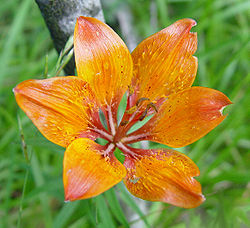Symbolism
 Flowers are common subjects of still life paintings, such as this one by Ambrosius Bosschaert the Elder |
Many flowers have important symbolic meanings in Western culture. The practice of assigning meanings to flowers is known as floriography. Some of the more common examples include:
- Red roses are given as a symbol of love, beauty, and passion.
- Poppies are a symbol of consolation in time of death. In the UK, New Zealand, Australia and Canada, red poppies are worn to commemorate soldiers who have died in times of war.
- Irises/Lily are used in burials as a symbol referring to "resurrection/life". It is also associated with stars (sun) and its petals blooming/shining.
- Daisies are a symbol of innocence.
Flowers within art are also representative of the female genitalia, as seen in the works of artists such as Georgia O'Keefe, Imogen Cunningham, Veronica Ruiz de Velasco, and Judy Chicago, and in fact in Asian and western classical art. Many cultures around the world have a marked tendency to associate flowers with femininity.
The great variety of delicate and beautiful flowers has inspired the works of numerous poets, especially from the 18th-19th century Romantic era. Famous examples include William Wordsworth's I Wandered Lonely as a Cloud and William Blake's Ah! Sun-Flower.
Because of their varied and colorful appearance, flowers have long been a favorite subject of visual artists as well. Some of the most celebrated paintings from well-known painters are of flowers, such as Van Gogh's sunflowers series or Monet's water lilies. Flowers are also dried, freeze dried and pressed in order to create permanent, three-dimensional pieces of flower art.
The Roman goddess of flowers, gardens, and the season of Spring is Flora. The Greek goddess of spring, flowers and nature is Chloris.
In Hindu mythology, flowers have a significant status. Vishnu, one of the three major gods in the Hindu system, is often depicted standing straight on a lotus flower.[11] Apart from the association with Vishnu, the Hindu tradition also considers the lotus to have spiritual significance.[12] For example, it figures in the Hindu stories of creation.[13]
Usage
In modern times, people have sought ways to cultivate, buy, wear, or otherwise be around flowers and blooming plants, partly because of their agreeable appearance and smell. Around the world, people use flowers for a wide range of events and functions that, cumulatively, encompass one's lifetime:
- For new births or Christenings
- As a corsage or boutonniere to be worn at social functions or for holidays
- As tokens of love or esteem
- For wedding flowers for the bridal party, and decorations for the hall
- As brightening decorations within the home
- As a gift of remembrance for bon voyage parties, welcome home parties, and "thinking of you" gifts
- For funeral flowers and expressions of sympathy for the grieving
People therefore grow flowers around their homes, dedicate entire parts of their living space to flower gardens, pick wildflowers, or buy flowers from florists who depend on an entire network of commercial growers and shippers to support their trade.
Flowers provide less food than other major plants parts (seeds, fruits, roots, stems and leaves) but they provide several important foods and spices. Flower vegetables include broccoli, cauliflower and artichoke. The most expensive spice, saffron, consists of dried stigmas of a crocus. Other flower spices are cloves and capers. Hops flowers are used to flavor beer. Marigold flowers are fed to chickens to give their egg yolks a golden yellow color, which consumers find more desirable. Dandelion flowers are often made into wine. Bee Pollen, pollen collected from bees, is considered a health food by some people. Honey consists of bee-processed flower nectar and is often named for the type of flower, e.g. orange blossom honey, clover honey and tupelo honey.
Hundreds of fresh flowers are edible but few are widely marketed as food. They are often used to add color and flavor to salads. Squash flowers are dipped in breadcrumbs and fried. Edible flowers include nasturtium, chrysanthemum, carnation, cattail, honeysuckle, chicory, cornflower, Canna, and sunflower. Some edible flowers are sometimes candied such as daisy and rose (you may also come across a candied pansy).
Flowers can also be made into herbal teas. Dried flowers such as chrysanthemum, rose, jasmine, camomile are infused into tea both for their fragrance and medical properties. Sometimes, they are also mixed with tea leaves for the added fragrance.




Tidak ada komentar:
Posting Komentar